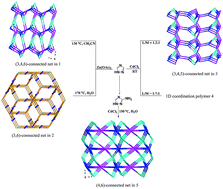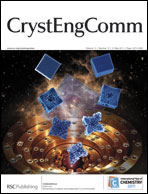Five members of the Zn/Cd triazolate family, [Zn(TAZ)(OAc)]n (1), [Zn4(TAZ)6(OAc)2]n (2), [Cd3Cl3(TAZ)3(DMF)2]n (3), [CdCl2(TAZ)]n·n(H2O) (4) and [Cd2Cl(μ4-AmTAZ)2(μ-AmTAZ)]n (5), have been synthesized from TAZ/AmTAZ and corresponding metal salts, where TAZ, AmTAZ and DMF are 1,2,4-triazole, 3-amino-1,2,4-triazole and N,N′-dimethylformamide, respectively. X-ray analysis shows that all compounds except 4 manifest interesting 3D frameworks with novel topologies. Compounds 1 and 2 are temperature-and-solvent controlled assemblies and possess 3D (3,4,6)-connected (3.72)2(32.4.73)(32.4.76.86) topology and 3D (3,6)-connected (4.82)3(83)(46.86.123) topology, respectively. However, compounds 3 and 4 are molar-ratio-dependent compounds. The framework of 3 is a 3D (3,4,5)-connected one with (4.102)(4.62)2(43.62.8)2(64.106) topology, in which the 1D channels are filled with coordinated DMF, while only a 1D chain-like motif is formed in 4. In addition, a 3D (4,6)-connected (3.42.52.6)2(32.42.54.65.72)(32.44.54.64.7) topology is observed in the framework of 5, where AmTAZ is used instead of TAZ in the syntheses of compounds 1–4. Solid state measurements reveal that all these coordination polymers are thermostable and luminescent under ambient conditions.


 Please wait while we load your content...
Please wait while we load your content...